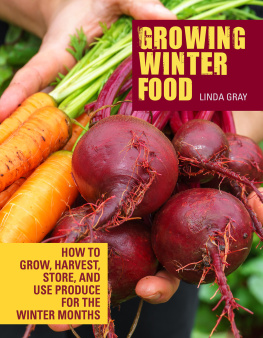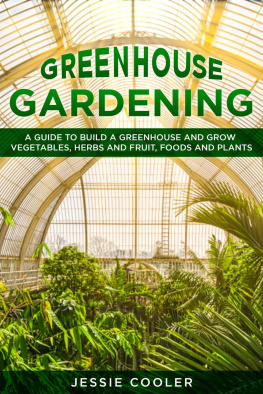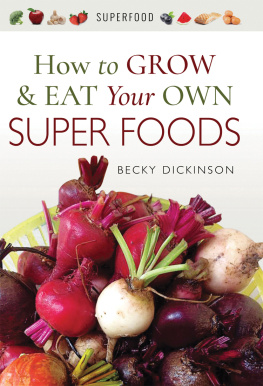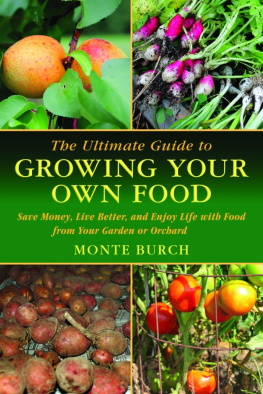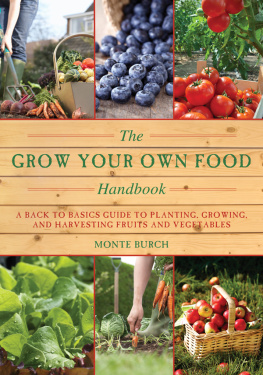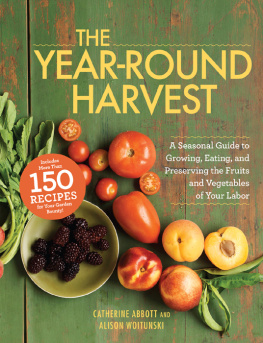All rights reserved. No part of this publication may be reproduced, distributed, or transmitted in any form or by any means, including photocopying, recording, or other electronic or mechanical methods, without the prior written permission of the publisher, except in the case of brief quotations embodied in critical reviews and certain other non-commercial uses permitted by copyright law. For permission requests, write to the publisher.
Any person who commits any unauthorized act in relation to this publication may be liable to criminal prosecution and civil claims for damages.
Quantity sales: Special discounts are available on quantity purchases by corporations, associations, and others. For details, contact the publisher at the address below.
Introduction
My name is Marian Prince and I have loved gardening for as long as I can remember. Some of it is probably genetics, as my grandfather worked in greenhouses in Burnaby, B.C., from the time he immigrated to Canada from Britain in the early 1900s. When my mother was old enough to work in the greenhouses, it was her favorite place to go as well.
As a child, we always had a backyard garden. I probably wasnt the best help to my mom, but it always gave me a peaceful feeling to be in our garden plot, learning to differentiate the weeds from the garden plants.
At the ripe age of 12, my mom gave me my own garden space. I chose to grow pumpkins, and what a success they were. I was a little disappointed with their shape, as they were the elongated variety, not the round variety as I had hoped for. However, that was the true start to my desire to be involved in horticulture.
As an adult, my very first home-gardening attempt was a complete flop and deflated me for some time. I was living on Lasqueti Island, a tiny island in the Gulf of Georgia, at the time. I had carefully chosen the garden site, making sure it was near the house and near a good water source. It also had excellent sun exposure, so I got down to digging, raking, and preparing the soil. I had my seeds in hand and started the planting process. I was using the in-ground row-planting method and had my markers at each end of the rows, you know, with the seed packages turned upside down on the wooden stakes. I had hills nicely mounded for the squash and pumpkins, with three seeds in each hill as per the planting instructions. My seed potatoes were nicely hilled and everything looked perfect. A lot of work and it was planted. I just had to sit back and watch it grow, or so I thought. The day after all of my excitement and hard work, I got up to have a look at my beautiful garden plot only to see that it had been completely destroyed. The free-range cows had decided to pay me a visit overnight and trampled the whole thing until nothing was left. What a bitter disappointment that was. Next time round, I would have fencing around the garden plot and no free-range cows anywhere near!
My next garden was very successful. I was now living in Sechelt on the Sunshine Coast and had a large garden plot area on 1/3 of an acre. It was close to the backdoor in a sunny spot, and the water source was right handy to the entire area. I went to local sawmills to pick up the ends and seconds of rough-cut boards in order to build a fence around my garden. There werent any free-range cows in the area, but I now had four children, a couple of dogs, and was horse sitting Rosy for my brother-in-law. No chances taken; my garden needed protection! I used Rosies manure (composted of course) and had the most awesome peas and cucumbers ever. During this time, I discovered square-foot gardening. This changed my whole outlook on gardening and I adopted this method wholeheartedly. I dont recall how I ended up with the book, SQUARE FOOT GARDENING, written by Mel Bartholomew, but it was a complete game changer for me. I highly recommend the book for any and all gardeners alike.
Years later, I moved to the Okanagan Valley in South Central British Columbia and received the Practical Horticulture Certification at Caribou College in Kamloops, B.C. (now Thompson Rivers University). I have worked in the forestry industry doing silviculture surveys and timber cruising. I have had a career as a landscape designer, landscape estimator, nursery worker, and landscaper for over 15 years. And I never gave up my love of being an active home gardener and food preserver, giving me over 45 years experience in this field.
I am writing this book now to share some of my successes and failures with gardening enthusiasts everywhere. Whether you are new to gardening, a beginner gardener, or a seasoned gardener, you will find some little tidbits of helpful information throughout these pages.
Chapter One
Planning Your Garden
So, how many of you have planted a garden in the past? Do you get all excited in the spring with many seed packets and nursery seedlings in hand? Have you been able to get all of your seeds and seedlings planted? Have you been able to find the time to maintain that garden? What happened? Did you lose interest in it because it became too time consuming, or did it become overrun, becoming a forest where you could no longer distinguish the plants from the weeds?
How many of you have been able to harvest the crops from the garden you planted? Did you find you had too many of one crop and not enough of another? Were your plants overcrowded and becoming spindly with little to no fruits? Did you have one crop overtaking the rest of your crops?
Did you know what to do with the remainder of your harvest, or did it fall to the ground and rot away?
After your initial build, which will take some time, effort, and a bit of expense, this book is designed to make gardening easy, practical, productive, fun, and not a chore. You will be amazed at how a few practical steps will change the way you are used to gardening. After all, the final harvest is the main goal for having a garden, right?

Choosing the Best Site for Your Garden
Sunny Location: Most plants, especially the warm weather crops, like at least eight hours of sunlight per day but will still do okay with six hours. Root crops will do okay with foursix hours of sunlight, and the cool weather crops are fine with threefour hours of sun. Sun is the key ingredient for plant photosynthesis, a process that gives the plants their energy. Try to plan your garden running east to west for the best sun exposure. Also, be sure to shelter your crops from strong winds without shading them from overhead trees. Oh, and dont forget to have a nearby water source.


